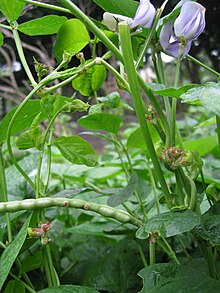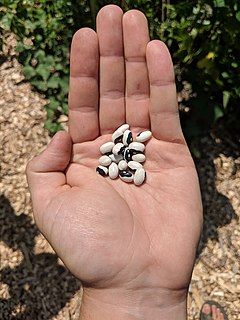
A bean is the seed of one of several genera of the flowering plant family Fabaceae, which are used as vegetables for human or animal food. They can be cooked in many different ways, including boiling, frying, and baking, and are used in several traditional dishes throughout the world.

The gooseberry, with scientific names Ribes uva-crispa, is a species of Ribes.
Good agricultural practice (GAP) is a certification system for agriculture, specifying procedures that must be implemented to create food for consumers or further processing that is safe and wholesome, using sustainable methods. While there are numerous competing definitions of what methods constitute good agricultural practice there are several broadly accepted schemes that producers can adhere to.
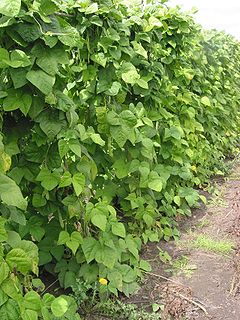
Phaseolus is a genus of herbaceous to woody annual and perennial vines in the family Fabaceae containing about 70 plant species, all native to the Americas, primarily Mesoamerica.

The black-eyed pea, black-eyed bean, or goat pea is a legume grown around the world for its medium-sized, edible bean. Its other common name is cowpea, although it is actually a subspecies of the cowpea.

The cowpea is an annual herbaceous legume from the genus Vigna. Due to its tolerance for sandy soil and low rainfall, it is an important crop in the semiarid regions across Africa and Asia. It requires very few inputs, as the plant's root nodules are able to fix atmospheric nitrogen, making it a valuable crop for resource-poor farmers and well-suited to intercropping with other crops. The whole plant is used as forage for animals, with its use as cattle feed likely responsible for its name.

Vigna is a genus of flowering plants in the legume family, Fabaceae, with a pantropical distribution. It includes some well-known cultivated species, including many types of beans. Some are former members of the genus Phaseolus. According to Hortus Third, Vigna differs from Phaseolus in biochemistry and pollen structure, and in details of the style and stipules.

Paderno Ponchielli is a comune in the province of Cremona, in Lombardy, northern Italy.

The asparagus bean is a legume cultivated for its edible green pods containing immature seeds, like the green bean. It is also known as the yardlong bean, long-podded cowpea, Chinese long bean, bodi/bora, snake bean, or pea bean. Despite the common name of "yardlong", the pods are actually only about half a yard long, so the subspecies name sesquipedalis is a more accurate approximation.
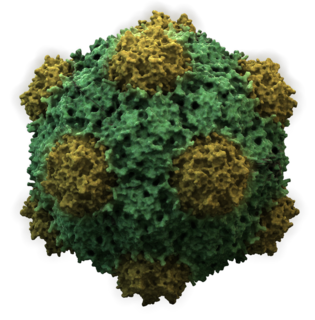
Cowpea mosaic virus (CPMV) is a non-enveloped plant virus of the comovirus group. Infection of a susceptible cowpea leaf causes a "mosaic" pattern in the leaf, and results in high virus yields. Its genome consists of 2 molecules of positive-sense RNA which are separately encapsidated. Both RNA1 and RNA2 have a VPg at the 5'end, and polyadenylation at the 3' end. Genomic RNA1 and RNA2 are expressed by a polyprotein processing strategy. RNA1 encodes helicase, VPg, protease and RdRp. RNA2 encodes movement protein and coat protein. The virus particles are 28 nm in diameter and contain 60 copies each of a Large (L) and Small (S) coat protein. The structure is well characterised to atomic resolution, and the viral particles are thermostable. The identification of the virus is attributed to Lister and Thresh in 1955, but it is now known as a variant of the Sunn-hemp mosaic virus.
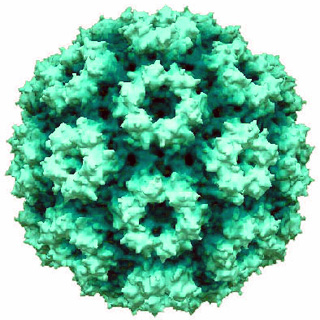
Cowpea chlorotic mottle virus, known by the abbreviation CCMV, is a virus that specifically infects the cowpea plant, or black-eyed pea. The leaves of infected plants develop yellow spots, hence the name "chlorotic". Similar to its "brother" virus, Cowpea mosaic virus (CPMV), CCMV is produced in high yield in plants. In the natural host, viral particles can be produced at 1–2 mg per gram of infected leaf tissue. Belonging to the bromovirus genus, cowpea chlorotic mottle virus (CCMV) is a small spherical plant virus. Other members of this genus include the brome mosaic virus (BMV) and the broad bean mottle virus (BBMV).
AIR synthetase is the fifth enzyme in the de novo synthesis of purine nucleotides. It catalyzes the reaction to form 5-aminoimidazole ribotide (AIR) from formylglycinamidine-ribonucleotide FGAM. This reaction closes the ring and produces a 5-membered imidazole ring of the purine nucleus (AIR):
Mycosphaerella cruenta, also called Pseudocercosopora cruenta in its asexual stage, is a fungal plant pathogen belonging to the group Ascomycota. It can affect several legume plants, including species of Phaseolus, Vigna, Calopogonium, Lablab niger, Mucuna and Stizolobium deeringianum [Mucuna pruriens][2]. It causes cowpea cercospora leaf spot, one of the most widespread and significant plant diseases in Africa and Asia. A city in China reported a 100% Mycosphaerella cruenta infection rate on cowpea in 2014[5]. In Africa, an epidemic can cause a yield loss of up to 40% [3].

Cowpea mild mottle virus (CPMMV) is a plant pathogenic virus of the family Betaflexiviridae that infects yardlong beans, soybeans and peanuts. It is transmitted by whiteflies that feed on the underside of plant leaves. Symptoms of infection include leaf malformation and mosaic, or spotted, patterns on the leaves. According to the Handbook of Plant Virus Diseases, the pathogen is found in "China, India, Indonesia, Ivory Coast, Nigeria, Thailand, Philippines, Papua New Guinea [and] Sudan".

Maruca vitrata is a pantropical insect pest of leguminous crops like pigeon pea, cowpea, mung bean and soybean. Its common names include the maruca pod borer, bean pod borer, soybean pod borer, mung moth, and the legume pod borer. The species was first described by Johan Christian Fabricius in 1787.

Vigna marina is a prostrate, creeping vine and a perennial plant. Also known as the beach pea, nanea, and notched cowpea, it is a species of legume in the family Fabaceae,.

Comovirus is a genus of viruses in the order Picornavirales, in the family Secoviridae, in the subfamily Comovirinae. Plants serve as natural hosts. There are currently 15 species in this genus including the type species Cowpea mosaic virus.
Idah Sithole-Niang is a Zimbabwean biochemist and educator. Her main area of research has been viruses which attack the cowpea, one of the major food crops of Zimbabwe.

Vigna luteola, commonly known as the hairy cowpea, is a perennial vine found in many tropical areas.
Virus nanotechnology is the use of viruses as a source of nanoparticles for biomedical purposes. Viruses consist of a genome and a capsid; and some viruses are enveloped. Most virus capsids measure between 20-500 nm in diameter. Because of their nanometer size dimensions, viruses have been considered as naturally occurring nanoparticles. Virus nanoparticles have been subject to the nanoscience and nanoengineering disciplines. Viruses can be regarded as prefabricated nanoparticles. Many different viruses have been studied for various applications in nanotechnology: for example, mammalian viruses are being developed as vectors for gene delivery, and bacteriophages and plant viruses have been used in drug delivery and imaging applications as well as in vaccines and immunotherapy intervention.
